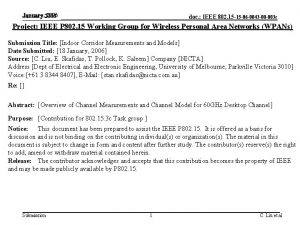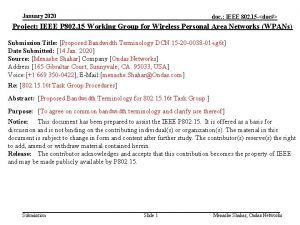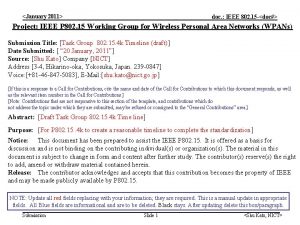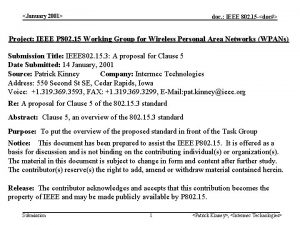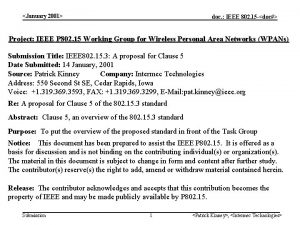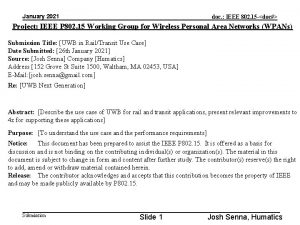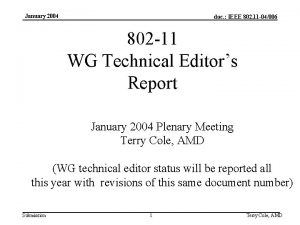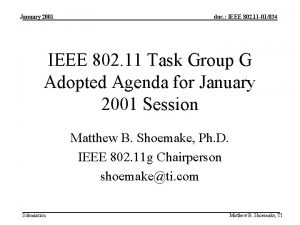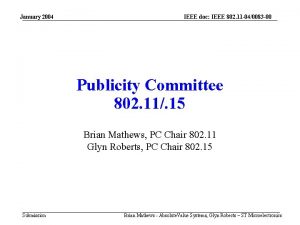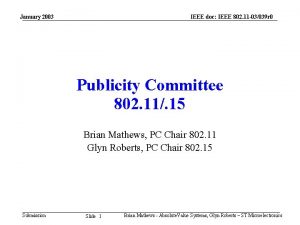January 2018 doc IEEE 802 11 190089 r












![January 2018 doc. : IEEE 802. 11 -19/0089 r 0 References [1] IEEE Std January 2018 doc. : IEEE 802. 11 -19/0089 r 0 References [1] IEEE Std](https://slidetodoc.com/presentation_image_h2/c5376816ee53467f440c342c03a04e33/image-13.jpg)
- Slides: 13

January 2018 doc. : IEEE 802. 11 -19/0089 r 0 Distributed MU-MIMO Architecture Design Considerations Date: 2018 -12 -21 Authors: Name Affiliation Address Phone Email David Lopez-Perez Mika Kasslin Henkka Rantala Eric Torkildson Nokia Lorenzo Galati Adrian Garcia Submission Slide 1 David Lopez-Perez, Nokia

K N io sv e m o b n e r R y 2 u , 0 1 8 L G E l e January 2018 doc. : IEEE 802. 11 -19/0089 r 0 Introduction • Distributed MIMO – a. k. a. D-MIMO – is a wireless technology, through which a network can realize joint transmissions/receptions from multiple non-collocated time- & phase-synchronized transmitters to multiple non-collocated time- & phase-synchronized receivers • D-MIMO presents a number of benefits ‑ Enhances multiplexing capabilities ‑ Mitigates inter-cell interference ‑ Leads to better spatial reuse • It also has challenges ‑ Channel sounding ‑ Synchronization ‑ Architecture Submission D-MIMO Slide 2 David Lopez-Perez, Nokia

January 2018 doc. : IEEE 802. 11 -19/0089 r 0 D-MU-MIMO-related proposals in EHT • In previous EHT TIG/SG meetings, D-MIMO has attracted considerable attention, touching on a number of topics ‑ Motivation for EHT 11 -18 -1461: Discussions on the PHY features for EHT Xiaogang Chen, Intel 11 -18 -1533: View on EHT Candidate Features Yusuke Tanaka, Sony 11 -18 -1547: Technology Features for 802. 11 EHT Kome Oteri, Inter. Digital ‑ Usage of the right terminology and nomenclature in EHT 11 -18 -1926: Terminology for AP Coordination Sameer Vermani, Qualcomm 11 -18 -1509: Discussions on Multi-AP Coordination Jianhan Liu, Media. Tek 11 -18 -1576: Considerations on AP Coordination Bo (Boyce) Yang, Huawei ‑ MIMO channel sounding issues and enhancements Submission 11 -18 -1191: MU sounding improvements Sigurd Schelstraete, Quantenna 11 -18 -1982: Consideration on multi-AP coordination for EHT Kiseon Ryu, LG electronics Slide 3 David Lopez-Perez, Nokia

January 2018 doc. : IEEE 802. 11 -19/0089 r 0 D-MU-MIMO-related proposals in EHT ‑ D-MIMO synchronisation issues and enhancements 11 -18 -1439: Constrained Distributed MU-MIMO Ron Porat, Broadcom 11 -18 -1962: Initial Distributed MU-MIMO Simulations Ron Porat, Broadcom 11 -18 -1510: AP Coordinated Beamforming for EHT Sudhir Srinivasa, Marvell • None of the above contributions relate to the system architecture and/or propose a reference model for D-MIMO ‑ Concepts such as mater AP, ethernet backhaul, etc. are mentioned, but not addressed specifically [11 -18 -1439][11 -18 -1962] [11 -18 -1982] In this contribution, we highlight the need for a new reference model to realize an efficient D-MIMO oriented architecture Submission Slide 4 David Lopez-Perez, Nokia

January 2018 doc. : IEEE 802. 11 -19/0089 r 0 D-MIMO Arch. for DL/UL processing Internet Router Control plane + data plane fronthaul D-MIMO AP 1 D-MIMO PU D-MIMO AP 2 D-MIMO AP 3 • A logical D-MIMO processing unit (PU) is added to the architecture, which ‑ buffers all the downlink source data ‑ selects the transmission direction, the nodes to be used in such transmission, the amount of data to transmit, the precoder, etc. ‑ precodes and forwards precoded I/Q samples to the TX nodes over the fronthaul for transmission [downlink] ‑ receives I/Q samples from the RX nodes over the fronthaul and jointly processes them for reception [uplink] • The D-MIMO PU can be co-located with an D-MIMO AP, the Master AP, or sit on its own D-MIMO PU to deal with distributed UL joint processing Submission Slide 5 David Lopez-Perez, Nokia

January 2018 doc. : IEEE 802. 11 -19/0089 r 0 High-Capacity Out-band Fronthaul Bandwidth 20 MHz 40 MHz 80 MHz 160 MHz 320 MHz Sym. duration (us) 12. 8 Samples/symbol 256 512 1024 2048 4096 Bits/complex sample 24 24 24 Req’d Gbps/antenna 0. 48 0. 96 1. 92 3. 84 7. 68 • • • For joint reception, a high-capacity, low-latency fronthaul is needed between the D-MIMO APs and the D-MIMO PU to distribute I/Q samples in near real time, see the above table For example, when looking at D-MIMO APs with 4 antennas and handling 80 MHz, each D-MIMO AP requires a 7. 68 Gbps fronthaul Such requirements are hard to meet in sub-6 GHz bands, thus advocating for wired or mm. Wave fronthaul solutions Wired or mm. Wave fronthaul to distribute I/Q samples in near real time Submission Slide 6 David Lopez-Perez, Nokia

January 2018 doc. : IEEE 802. 11 -19/0089 r 0 Distributed Channel Access Function • In 802. 11, stations share the channel using carrier sense multiple access with collision avoidance (CSMA/CA) [1] • The channel must be idle prior to channel access • With conventional APs, its co-located antennas are likely to share a common view of the channel state (idle/busy) • With D-MIMO, the physical separation between D-MIMO APs leads to different views of the channel state, making such channel state decisions (idle/busy) ambiguous idle channel D-MIMO PU/AP 1 d. AP 2 d. AP 3 d. AP 4 busy idle ambiguous channel view Centralised carrier sensing to deal with ambiguous channel state assessments Submission Slide 7 David Lopez-Perez, Nokia

January 2018 doc. : IEEE 802. 11 -19/0089 r 0 Example of Centralized CSMA/CA CCA statuses sent to D-MIMO PU/AP 1 over fronthaul network d. AP 2 AP 1/PU AP 2 D-MIMO PU/AP 1 CSMA/CA d. AP 3 DMIMO Trigger Control plane + data plane fronthaul d. AP 4 Joint TX BUSY CHANNEL AP 3 Joint TX AP 4 Joint TX Distribute precoded data over the fronthual • The D-MIMO PU (collocated with the Master AP in the figure) ‑ runs the CSMA/CA function of the D-MIMO group, formed by the D-MIMO APs in the figure [2] ‑ sends a D-MIMO trigger, when such centralized CSMA/CA function deems the channel idle, indicating which D-MIMO APs are part of the D-MIMO transmission, and providing a reference for synchronization [11 -18 -1962] D-MIMO PU handles CSMA/CA info from multiple non-collocated MAC layers Submission Slide 8 David Lopez-Perez, Nokia

January 2018 doc. : IEEE 802. 11 -19/0089 r 0 Existing arch. reference models: Multiple MAC sublayer management entity • Traditionally, a Wi-Fi device may contain one or more STAs – thus having multiple MAC sublayers – that share the same PHY layer [1] ‑ A multiple MAC station management entity (MM-SME) coordinates these multiple MAC sublayers sharing the same PHY layer, and controls parameters such as power management mode, DMG antenna configuration, and other parameters, as well as the statuses of the coordinated STAs (see 4. 9. 3 of [1]) • Each STA may also have multiple channel access functions (DCF/ EDCAFs/…) • In both cases, the different CSMA/CA functions of the multiple co-located MAC sublayers are uncoordinated, and do not share related information, such as ‑ NAV state ‑ Physical carrier sense (CS) status Current reference models do not accommodate for centralised CSMA/CA Submission Slide 9 David Lopez-Perez, Nokia

January 2018 doc. : IEEE 802. 11 -19/0089 r 0 Existing arch. reference models: Multiband management entity • The station management entity (SME) of a multi-band capable device also contains a multi-band management entity that manages multiple MAC sublayers [1], ‑ This multi-band management entity facilitates a pair of multi-band capable devices to discover, sync, (de)authenticate, (dis)associate, manage resources and transfer sessions from a band/channel to another band/channel (see 4. 9. 4 of [1]) ‑ For transparent FST, a shared multi-band management entity has access to the local information within each SME; and in this case, the state information includes block agreements, TSs, association state, RSNA, security keys, sequence counter, and PN counter (See figure) Submission Slide 10 David Lopez-Perez, Nokia

January 2018 doc. : IEEE 802. 11 -19/0089 r 0 Existing arch. reference models: Multiband management entity • Similarly as in the multiple MAC sublayer management entity, the different CSMA/CA functions across the multiple co-located MAC sublayers of a multiband capable device are uncoordinated, and do not share related information, such as ‑ NAV state ‑ Physical carrier sense (CS) status Current reference models do not accommodate for centralised CSMA/CA Submission Slide 11 David Lopez-Perez, Nokia

January 2018 doc. : IEEE 802. 11 -19/0089 r 0 Proposed multiple MAC sublayers enhancements for D-MIMO • To realize efficient D-MIMO transmissions, we propose that the EHT group specifies a reference model and interfaces for D-MIMO operation, building on the existing ones, where a new multiple MAC D-MIMO management entity (MM-DME) ‑ shall coordinate the D-MIMO related actions of the multiple non-collocated DMIMO APs that do not share the same antennas and form a D-MIMO group, e. g. ‑ shall manage the CSMA/CA function of all coordinated D-MIMO APs ‑ shall have access to information on NAV and physical carrier sense statuses in addition to the transmission status of all coordinated D-MIMO APs ‑ may use a high-capacity wired or wireless fronthaul to exchange information required for coordination and data samples ‑ may sit on the D-MIMO PU • Other architecture related topics also need attention (e. g. MAC/PHY splitting) Propose to study in detail a new reference arch. for D-MIMO Submission Slide 12 David Lopez-Perez, Nokia
![January 2018 doc IEEE 802 11 190089 r 0 References 1 IEEE Std January 2018 doc. : IEEE 802. 11 -19/0089 r 0 References [1] IEEE Std](https://slidetodoc.com/presentation_image_h2/c5376816ee53467f440c342c03a04e33/image-13.jpg)
January 2018 doc. : IEEE 802. 11 -19/0089 r 0 References [1] IEEE Std 802. 11 -2016. IEEE Standard for Information Technology—Local and Metropolitan Area Networks— Specific Requirements. Part 11: Wireless LAN MAC and PHY Specifications. [2] Neelakantan Nurani Krishnan, Eric Torkildson, Enrico Rantala, Ivan Seskar, Narayan Mandayam, and Klaus Doppler, “D-MIMOO – Distributed MIMO for Office Wi. Fi Networks, ” at IEEE Dy. Span, 2018. Submission Slide 13 David Lopez-Perez, Nokia














